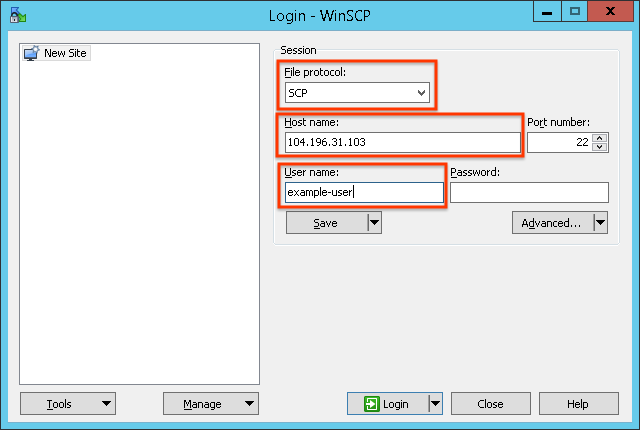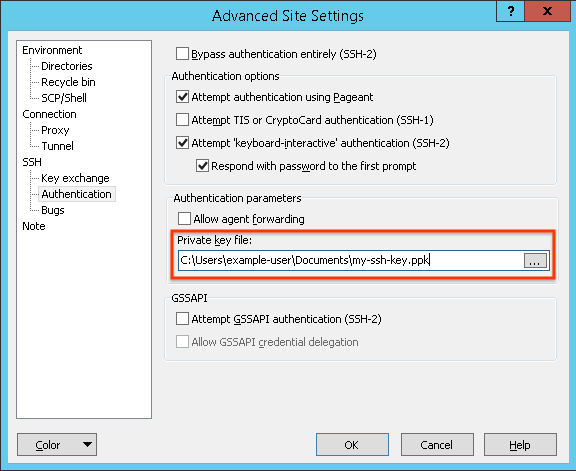What Is the Google Ip Address for Uploading Videos
Linux
To transfer files to Compute Engine VM instances, dissimilar options are bachelor depending on your workstation Os and the target VM instance Os.
| Transfer from | To Linux VMs |
|---|---|
| Linux or macOS |
|
| Windows |
|
Transfer files through Cloud Storage
Cloud Storage buckets can be a convenient intermediate transfer point betwixt you and your VMs.
This file transfer method works on nearly all operating systems and VM types every bit long as your VM has admission to your Deject Storage bucket through a service account or through your personal user credentials.
Upload your files from your workstation to a Deject Storage bucket. And so, download those files from the bucket to your instances.
- Create a Cloud Storage bucket or identify an existing bucket that you want to use to transfer files.
- From your workstation, upload files to the bucket.
- Connect to your VM using SSH.
- On your VM, download files from the bucket.
If yous need to transfer files in the other management, opposite the process. Upload the files from your VM, and and then download those files to your workstation.
Transfer files using SSH in the browser
If y'all can establish an SSH connection to a VM using the SSH from the Browser window, you tin can use that connectedness to transfer files to the VM.
- In the Cloud Console, go to the VM instances page.
Become to VM instances
- In the listing of virtual machine instances, click SSH in the row of the example that you lot want to connect to.

- After the connection is established, click the gear icon in the upper right of the SSH from the Browser window and select Upload file. Alternatively, select Download file to download a file from the VM.

- The transfer dialog opens. Specify which file you lot want to transfer.
If you uploaded a file, the file is in your /domicile/USER directory.
If you lot downloaded a file, the file is in the default download folder on your local workstation.
Transfer files using the Google Cloud CLI
The Google Cloud CLI provides an SCP file transfer utility, creating an SSH primal pair for you the first time yous connect. Your private key is stored on your local device and its corresponding public key is copied to project or VM instance metadata.
To transfer files using SCP, you lot must have a firewall dominion on the network that your VM uses that allows SSH connections on port 22. Y'all can verify that this firewall rules exists by looking for a firewall rule that allows tcp:22 connections in the Google Deject Console.
Go to Firewall rules
If you don't have a firewall rule that allows SSH connections on port 22, create the firewall rule.
Yous can install the gcloud CLI and use it to copy files and directories to your VM using the scp control.
The post-obit example copies a file from your workstation to the domicile directory of the VM.
gcloud compute scp LOCAL_FILE_PATH VM_NAME:~
Replace the following:
-
LOCAL_FILE_PATH: the path to the file on your workstation -
VM_NAME: the name of your VM
Y'all tin can besides copy files and directories from a VM to your local workstation. The following case recursively copies a directory from your VM (the source) to your local workstation (the destination).
gcloud compute scp --recurse VM_NAME:REMOTE_DIR LOCAL_DIR
Replace the following:
-
VM_NAME: the proper noun of the VM -
REMOTE_DIR: the path to the directory on your VM -
LOCAL_DIR: the path where you want to put the directory on your workstation
For more data, see the gcloud compute scp reference documentation.
Transfer files using SCP on Linux and macOS workstations
The scp command-line tool works similarly to the gcloud compute scp command only requires you to manually manage your SSH keys.
To transfer files using SCP, you must have a firewall rule on the network that your VM uses that allows SSH connections on port 22. You tin can verify that this firewall rules exists by looking for a firewall rule that allows tcp:22 connections in the Google Deject Panel.
Go to Firewall rules
If y'all don't have a firewall rule that allows SSH connections on port 22, create the firewall rule.
The scp tool uses the same central files that yous utilize to connect to your instances using standard SSH.
-
If you have not nonetheless applied a public key to your Google Cloud Console projection or VM case, create an SSH cardinal pair and add the public key to project or instance metadata.
-
Notice the external IP for the VM that you want to send files to. In the Google Cloud Console, get to the VM instances page.
Go to VM instances
-
Use the
scptool to copy a file from your workstation to the dwelling house directory of the target VM. For this example, the individual key is at~/.ssh/my-ssh-key.scp -i ~/.ssh/my-ssh-key LOCAL_FILE_PATH USERNAME@IP_ADDRESS:~
Replace the following:
-
LOCAL_FILE_PATH: the name of the local file that you desire to upload -
USERNAME: your username -
IP-Accost: the external IP accost for your VM
-
You can likewise copy files from a VM to your local workstation by reversing the source and destination variables. For this instance, copy a file from your VM to a path on your workstation.
scp -i ~/.ssh/my-ssh-fundamental USERNAME@IP_ADDRESS:REMOTE_FILE_PATH LOCAL_FILE_PATH
Replace the following:
-
USERNAME: your username -
IP_ADDRESS: the external IP accost for your VM -
REMOTE_FILE_PATH: the name of the remote file that you lot want to download -
LOCAL_FILE_PATH: the location on your workstation where you want to download the file to
Transfer files using WinSCP on Windows workstations
On Windows workstations, the WinSCP customer lets you manage files on your instances through a graphical file browser interface.
WinSCP uses the aforementioned cardinal files that you utilise to connect to your instances using PuTTY.
-
Exercise the post-obit if you haven't configured cardinal-based SSH authentication for your instance:
-
Create an SSH key pair.
-
Add your public SSH central to your project's metadata or to your VM's metadata. For more information, meet Add SSH keys to project metadata or Add SSH keys to instance metadata.
-
-
Find the external IP for the VM that you want to send files to.
- In the Google Cloud Console, go to the VM instances folio.
Get to VM instances
- In the list of VMs, find the external IP address in the External IP column for your VM.
- In the Google Cloud Console, go to the VM instances folio.
-
Download and install WinSCP. The default install settings work for virtually users.
-
Start the WinSCP programme. A login window opens where yous can configure your connectedness settings.
-
In WinSCP, configure your connection settings.
-
Select
SCPas the file transfer protocol in the File protocol field. -
In the Host Name field, specify the external IP address for the VM that you want to connect to.
-
In the User name field, specify the Google username that you utilize to access your project. For this example, the user is
case-user.
-
-
Click the Advanced drib-down list to open the advanced settings, and navigate to SSH > Authentication.
-
In the Private primal file box, specify the path to your private key file of the SSH key pair that y'all created for the VM.

-
Click Ok to relieve the advanced settings.
-
Click Login to connect to your VM. If the connection is successful, the window opens your local file organization on the left and the VM's file organisation on the right. You lot tin can navigate to different directories in these file systems and elevate files to transfer them to and from your VM.
-
You probable practice non take permission to manage well-nigh files exterior of your dwelling directory of the VM. Navigate to the home directory of the VM:
/home/USERNAME
-
Utilise the WinSCP interface to move files between your workstation and the VM.
-
After you copy your files to the VM, connect to your instance so that you can execute or move files with full
sudopermissions.
What's next
- Connect to your instances to utilise the files that you uploaded.
dominguezbefousball.blogspot.com
Source: https://cloud.google.com/compute/docs/instances/transfer-files
Post a Comment for "What Is the Google Ip Address for Uploading Videos"